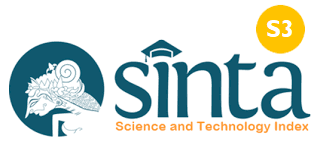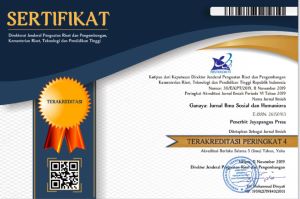Pengalaman Komunikasi Interpersonal Cosplayer
(Studi Fenomenologi atas Komunitas CCW di DKI Jakarta)
DOI:
https://doi.org/10.37329/ganaya.v8i1.3767Keywords:
cosplay, communication, interpersonal communicationAbstract
The cosplay trend has quickly developed into a subculture in Indonesia, especially among teenagers. This research aims to see how the cosplay phenomenon influences the development of interpersonal communication. This research uses a qualitative method with a phenomenological approach to achieve this goal. This approach was adopted to understand cosplayers' experiences and interpersonal communication perspectives thoroughly. Data was collected using several stages, including in-depth interviews with cosplayers, direct observation of their interactions in various cosplay scenarios, and joint documentation with them after the interview process was completed. Data processing and analysis are linked to interpersonal communication theory according to Joseph A. Devito to achieve effective interpersonal communication with the main characteristics, namely openness, empathy, supportive attitude, positive attitude, and equality. The results of this research show that there are differences in interpersonal communication between cosplayers when wearing costumes and when they are not. In addition, this research found that cosplay activities help cosplayers' self-development, especially in terms of communication skills.
References
Andreansyah, S. (2024). Interpersonal Communication Dynamics among Members at ‘Toygraphy ID’Community. Journal of Communication Principles and Applications, 1(1), 29-37.
Ardilla, A. D. (2022). Identity and Motif of Cosplayers Surabaya In 'Matsuri Ko Kami'Event. UNNOLLCS: Proceeding of Undergraduate Conference on Literature, Linguistic, and Cultural Studies, 1, 112-121.
Calinao, R. J. G., Dulay, C. A. M., Llamas, J. P. N. M., & Sajul, S. N. D. (2023). The Impacts Of The Emerging Popularity Of Cosplay In The Philippines. Asia-Pacific Journal of Innovation in Hospitality and Tourism, 12(3), 37-62.
Creswell, J. W. (2018). Reseach Design: Qualitative, Quantitative, and Mixed Method Approaches. Thousand Oaks: CA: Sage.
DeVito, J. A. (2016). The Interpersonal Communication Book 14th Edition. United States Publisher: Pearson Education.
Ezeokonkwo, F. C. (2023). Relationships Between Interpersonal Goals and Loneliness on Older Adults: A Cross-Sectional Study. International Journal of Environmental Research and Public Health, 20(3), 235-248.
Flood, A. (2010). Understanding Phenomenology. Nurse Researcher, 17(2), 7-15
Ghosh, S. (2024). The Concept of Self in Interpersonal Communication. International Journal of Research Culture Society, 8(3), 2456-6683.
Gioia, F. D. (2020). Vulnerable Narcissism And Body Image Centrality In Cosplay Pratice: A Sequential Mediation Model. Mediterranean Journal of Clinical Psychology, 8(3).
Halawa. N., & Lase, F. (2022). Pemarkah Kohesi Gramatikal Pasa Cerpen (Robohnya Surau Kami, Menara Doa, Kebencian Mamak Dan Seribu Kunang-Kunang Di Manhattan). Educatum: Jurnal Pendidikan, 1(2), 565-571.
Haley, B. M. (2024). Cosplay and the Impact on Body Image. University of St. Thomas.
Hikmah, Y. N., & Husnita H. (2023). FIRO Analysis As A Study Of Interpersonal Communication: Does GULALI Program Can Strengthening Character. International Journal of Education Technology and Learning, 14(1), 1-6.
Kirkpatrick, E. (2021). Cosplay . Keywords for Comics Studies, 63-67.
Lase, F. (2022). The Influence Of Classical Counseling, Bmb3 Strategy, Education In Understanding Of Addiction, Development Of Structured Positive Behavior On The Dangers Of Behavioral Addiction And Napsa. Edumaspul, 6(2), 3023-33.
Liang, Y. (2024). Things I've Learned From Doing Cosplay: An Investigation On Incorporating Atypical Creative Practices Into Art Education. Master Theses.
Ndiung, S., & Menggo, S. (2024). Problem-Based Learning Analysis In Strengthening College Students’ Interpersonal Communication Skill. Journal of Education and Learning (EduLearn), 18(4), 1350-1361.
Pramana, N. A., & Masykur, A. M. (2023). Cosplay Adalah Jalan Ninjaku Sebuah Interpretative Phenomenological Analysis. Jurnal Empati, 8(3), 646-654.
Santosa, Y. D., & Yuliana, N. (2024). Gambaran Communication Theory of Identity: Membangun Identitas Seorang Cosplayer. Jurnal Bisnis dan Komunikasi Digital, 1(4), 10-10.
Vardell, E., Wang, T., & Thomas, P. A. (2022). I Found What I Needed, Which Was A Supportive Community: An Ethnographic Study Of Shared Information Practices In An Online Cosplay Community. Journal of Documentation, 78(3), 564-579.
Yulian, S. B. (2019). Perilaku Komunikasi Otaku dalam Interaksi Sosial (Studi Fenomenologi Pada Anggota Komunitas Jepang Soshonbu Bandung). Jurnal Komunikasi, 13(2), 191-200.
Downloads
Published
How to Cite
Issue
Section
License
Copyright (c) 2025 Audina Chairunisa, Azwar Azwar (Author)

This work is licensed under a Creative Commons Attribution-ShareAlike 4.0 International License.
An author who publishes in the Ganaya : Jurnal Ilmu Sosial dan Humaniora agrees to the following terms:
- Author retains the copyright and grants the journal the right of first publication of the work simultaneously licensed under the Creative Commons Attribution-ShareAlike 4.0 License that allows others to share the work with an acknowledgement of the work's authorship and initial publication in this journal
- Author is able to enter into separate, additional contractual arrangements for the non-exclusive distribution of the journal's published version of the work (e.g., post it to an institutional repository or publish it in a book) with the acknowledgement of its initial publication in this journal.
- Author is permitted and encouraged to post his/her work online (e.g., in institutional repositories or on their website) prior to and during the submission process, as it can lead to productive exchanges, as well as earlier and greater citation of the published work (See The Effect of Open Access).
Read more about the Creative Commons Attribution-ShareAlike 4.0 Licence here: https://creativecommons.org/licenses/by-sa/4.0/.








